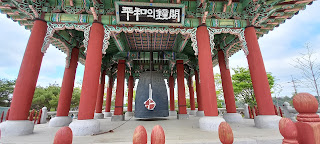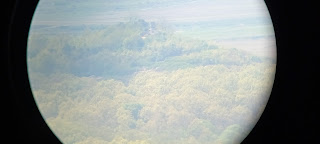For some reason, my fellow travellers found it funny when I started a sentence with "If you love a good border" as we crossed by land between Thailand and Laos. (The joke was on them, as it WAS very enjoyable, especially when we all had to pay a bribe to the border official). So, if you love a good border, they don't come much more exciting than the border between North and South Korea, where the demilitarised zone (DMZ) is located.
 |
| If we're being pedantic, it should really just be called the MZ |
A quick history. The Korean War in the 1950s was basically a proxy war between the USA / Soviet Union. As a result of the armistice, the country was split into two, and a demilitarised zone established between the two borders. Over the years, the DMZ, which roughly follows the 38th parallel, has become a nature reserve and a tourist attraction, yet lies between possibly the most fortified borders in the world. For most people, the DMZ also represents the closest most people will ever get to entering North Korea (including people in South Korea whose families were split up when the border was established).
As it is one of the most popular tourist attractions in South Korea, there is no shortage of tours offering to take you there. I chose the tour below, although I'm kinda regretting it now as I would have loved to see what "forced shopping" actually entails.

|
|
I'm imagining some sort of capitalist dystopia where you're
frogmarched round shops and forced to buy tat at gunpoint. |
The first stop of the tour was Imjingak Pyeonghoa-Nuri Park, located a couple of miles before the DMZ. It was a rather odd place. They had a peace bell, a "freedom" railway (that may eventually be used in the event of reunification), a train that was shelled about a thousand times, somewhere you could buy North Korean currency at a rather uncompetitive exchange rate, and a few other shops designed to make tourist part with their hard-earned Won.

|
| The peace bell |
They also had a statue to commemorate all the Korean "comfort women" who were forced to work as sex workers in Japan during the Sino-Japanese war. I didn't think it was the done thing to get my photo taken, but the tour guide encouraged me to sit down for a picture so I'm pretty sure I wasn't being disrespectful!

|
| I wasn't sure whether to smile or not, so I opted for an enigmatic Mona Lisa look |

|
| The railway leading to the Bridge of Freedom. Each sleeper gives a distance to a North Korean city. |

|
| A train used the Korean War |
And for the kids ...

|
|
... nothing says Peace and Reunification better than a theme
park |
We all then leapt on the bus again and proceeded to the DMZ, and it all got a bit exciting when we had to show our passports (even though we weren't going to be crossing any borders today unless we we planning to defect). Sadly, no photos were allowed, but imagine lots of young chaps with big guns and barbed wire, and you'll be on the right lines.
The next stop was much more interesting. The North Koreans have been digging
tunnels in the direction of South Korea, possibly to allow them to invade
(although they painted the tunnels black to make it look like they were
digging for coal). Four tunnels have been found in the last fifty years but
there may be many more out there.

|
| The map of the tunnel. There are three concrete barriers to prevent the North Koreans reopening it. |
The climb down to the tunnel was very long and steep, but once we were in the
tunnel dug by the North Koreans I kept banging my head off the roof supports,
since the average height of a North Korean soldier is much lower than the
average height of most other nationalities (thankfully they made us all wear fetching yellow crash helmets).
 |
| And what a dashing figure I cut in mine |
No cameras were allowed, but if you want an idea of what it was like, watch
this video by a guy who just blatantly ignored the no camera rule.
Outside the tunnel and waiting for my fellow tunnel enthusiasts (to be fair, a
1/4 mile climb at 11% elevation is pretty gruelling), I wandered slightly
off-piste and stumbled upon some South Korean soldiers sweeping for mines. It was fascinating, although I was a wee bit worried about getting shot for filming them, but then I
remembered that it was the demilitarised zone, so I filmed them with gay
abandon (for about 10 seconds).
Next up was the Dora observatory. Its main attraction was being able to see across the border into North Korea, including the
Potemkin village
of Kijong Dong, and various other places of interest. Weather-wise, it was a
fine day for spying on your closest neighbours, but even if it wasn't, one or two
binoculars were provided for your viewing pleasure.

|
| Make that about 50 |

|
| A feeble attempt to take a photo of a North Korea border guard through binoculars |
You also got a good view of the two flagpoles erected in a very childish
dick-waving contest between the two Koreas. Sadly (for me), or happily (for the people
living in the area), both sides agreed to refrain from blasting propaganda through massive speakers across the border a few years ago.
 |
| Click to expand. (Although it's still a shite photo even when enlarged). |
There was also a comfy lecture theatre type room which would be a cracking
place to observe any potential conflict between the two Koreas (although
sitting in a big building atop a hill, you'd also be a sitting
duck).
Then it was back on the bus for our final stop was a reunification
village (a place very close to the border where you don't pay taxes, but you
do have to eat
disgusting ice cream). Apparently people choose to live here to be closer to their families, not
that they're allowed to visit them. There wasn't much to see here, as
evidenced by the fact that I've not got any more pictures ...

|
| ... except datarobot showing his respect |
To sum up. The DMZ is a wee bit too touristy (says the guy who bought a fridge
magnet) and it would be ten times more interesting visiting the other side.
But all-in-all, a cracking day out.
Next up, more culture in Seoul.

Comments